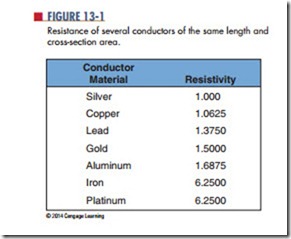as silver and copper offer little opposition to current flow. This chapter examines the characteristics of resistance, types of resistance, and the effects of connecting resistors together by a conductor to form a circuit.
Resistance
As previously mentioned, every material offers some resistance or opposition to the flow of current. Some conductors such as silver, copper, and aluminum offer very little resistance to current flow. Insulators such as glass, wood, and paper offer high resistance to current flow.
The size and type of wires in an electric circuit are chosen to keep the electrical resistance as low as possible. This allows the current to flow easily through the conductor. In an electric circuit, the larger the diameter of the wire, the lower the electrical resistance to current flow.
Temperature also affects the resistance of an electrical conductor. In most conductors (copper, aluminum, and so on), resistance increases with temperature. Carbon is an exception because the resistance de‑ creases as temperature increases. Certain alloys of metals (Manganin and Constantan) have resistance that does not change with temperature.
The relative resistance of several conductors of the Silver is used as a standard of 1, and the remaining metals are arranged in order of ascending resistance.
The resistance of an electric circuit is expressed by the symbol “R.” Manufactured circuit parts contain‑ ing definite amounts of resistance are called resistors. Resistance (R) is measured in ohms (V). One ohm is the resistance of a circuit or circuit element that per‑ mits a steady current flow of 1 ampere (1 coulomb per second) when 1 volt is applied to the circuit.
13–1 Questions
1. What is the difference between conductors and insulators?
2. How does the diameter of a piece of wire affect its resistance?
3. What factors affect the resistance of a conductor?
4. What material makes the best conductor?
5. Why is copper, rather than silver, used for wire?
